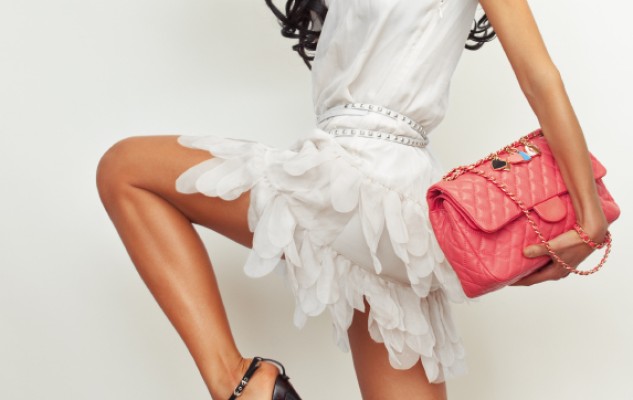
I’ve always been particular with my outfits. I still remember the dress I wore for my 5th grade photo. I was at a new, public school after switching from Catholic school (read: uniforms). Soon after that switch, we moved from Farmington Hills, MI to Hinsdale, IL. I distinctly remember some of my favorite outfits those first few days of that second new school. I’m thinking leggings with one side stripes and one side polka dots will definitely make a comeback…or not!
I managed for about a year with the clothes I had, but then the ‘I have nothing to wear’ tantrums started. My parents gave me a clothing allowance I could spend each season on whatever I wanted. I learned how to be strategic and get the best pieces for my money’s worth. I’ve been that way ever since.
Do you have a clothing budget?
No matter your income level, everyone needs to have a style budget. One of the first things I ask my clients is ‘how much do they normally spend on items?’ and ‘how much they’re willing to spend on an exquisite piece?’ From there, I know my parameters if I need to shop for them. I also know if I need to stretch and guide them a bit. Some clients give me a very specific budget when I’m shopping for them – and I love that – partly because it’s a challenge for me to hit that number perfectly and because it’s just plain smart.
Find your budget
Savvy women automatically defer a certain amount of their income into savings and retirement funds and are aware of their budgets. You should know your living expenses: utilities, car payments and maintenance, grocery bills, rent, etc. Once you knowthe amount you need to spend on your monthly necessities, you can look at the amount of disposable income remaining. Give yourself a budget for your clothes (as well as dining out, entertainment, etc.).
If you need help understanding where your money goes each month, Mint.com offers a free service that automatically tracks your spending in each area. You can also set a budget for yourself and Mint.com will track it for you. I love this tool!
You need to be realistic about your budget. If nice clothes are important to you, perhaps you can cut back your margarita budget.
Build a wardrobe you love
Give yourself a budget that ensures you’ll only buy pieces that really work for you instead of impulsively buying things to make yourself feel better. Whether you have $300, $500, $1000 per season, you want to maximize how far that goes. Even Lucky magazine, a great resource for shopping, has a column that shows three women with three different budgets for a season and what they buy with those budgets (and why) over the course of three months. Even on a $1,000 per season budget you need to examine why you want to buy something, what other items will work with that piece within your wardrobe, and how amazing it looks (and makes you feel).
Know when to spend vs. save
Always spend more on staples that you can mix and match with anything. This does not have to be a black suit and pumps. The foundation of your wardrobe could be brown, navy, purple –whichever colors work best for you and really speak to you! Even as your style evolves, these pieces will stand the test of time and serve as the base for many outfits yet to be inspired.
You should always spend more on a good suit that fits you well. Tailoring is an important investment, so take notice when you find a brand that fits you well. High quality cashmere and cotton sweaters are always a good investment as well. You should also have classic accessories to add to your outfits. My favorites are diamond studs (or pavé), gold or silver bangles, ring, and a solitaire or pendant necklace.
Finally, spend on anything you must have, especially if it’s an item from a designer you love who doesn’t produce many pieces of each style (designers and high end contemporary designers). If you’re at Banana Republic, Gap, J Crew or any other chain store, chances are it will go on sale. Try the item on in the store so you know your size and then stay informed of when that store is having an online sale.
Save on pieces you can only wear a couple of times or trendy items. Neon is a great example of a trend. It’s fun, but those colors are not going to be popular forever. If you want to play with a trend, find an accessory or an accent piece that is under $100 (less if your budget is lower). You’d be amazed at what a simple accessory can do for an otherwise basic outfit.
Please note that ‘save’ doesn’t translate to ‘cheap.’ Saving money really means knowing what you will or won’t spend on something as well as what you want to look for on sale. Thanks to a plethora of sample sale websites out there, it’s easy to find stylish, designer clothes on sale. In fact, I rarely pay retail – unless it’s something I must have right away!
Stretch your budget
If there’s an item you must have and simply can’t live or breathe without, go for it! It will make you feel fabulous because you look fabulous. Place yourself on a shopping fast for as long as it takes you to catch up. Meaning, if your budget is $300 per season, which is $100 per month and you want something that is $500, then you only have $100 to spend for the next season.
When you’re mindful of your budget, you won’t hang clothes in your closet with the price tags still on. That’s $25, $75, $250 wasted! If you do have clothing items like this in your closet, it’s nothing to beat yourself up over. However, it reinforces why you should only buy pieces you love and can immediately envision yourself wearing.
Leave a comment below: How much do you spend on clothes?
This Week's Articles Read, learn, live
-
 Summertime grilled vegetables
Summertime grilled vegetables
-
 5 Ways to make this summer full of unforgettable family fun
5 Ways to make this summer full of unforgettable family fun
-
 10 Reasons to take a family vacation in Puerto Vallarta
10 Reasons to take a family vacation in Puerto Vallarta
-
 5 Fun tips for spring cleaning with kids
5 Fun tips for spring cleaning with kids
-
 10 chick flicks with New Year’s Eve scenes
10 chick flicks with New Year’s Eve scenes
-
 The day after Christmas: 5 ways to handle the biggest downer of the year
The day after Christmas: 5 ways to handle the biggest downer of the year